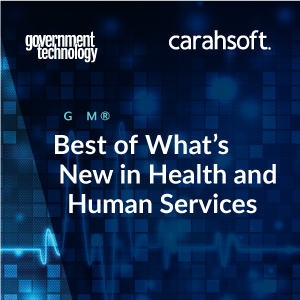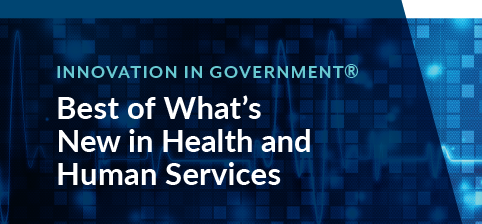The COVID-19 pandemic is forcing dramatic modernization. Driven by urgent social distancing requirements, Health and Human Services (HHS) organizations virtualized an array of services that traditionally have been performed face-to-face, and unlike typical HHS modernization projects, these changes happened with unprecedented speed. And although these moves were made in immediate response to the COVID pandemic, they’re likely to have long-term impacts on the digital experience for HHS clients, how and where HHS staff members work, and how these organizations purchase and deploy technology. Pandemic-driven uptake of virtual work and digital services could have long-term positive impacts on HHS workforces and the clients they serve; internally, these changes could improve employee satisfaction and retention within HHS organizations. Learn the latest insights from industry thought leaders in healthcare in Carahsoft’s Innovation in Government® report.
Focusing on Outcomes that Matter
“One place that organizations get stuck is in ‘good enough.’ Unless something’s horribly broken, they stay with what works today instead of pursuing continuous improvement cycles that include customer satisfaction. Organizations that are satisfied with their current operation and their current level of service tend not to want to adopt — or can’t adopt quickly — opportunities that digital technology can offer. Change is exponentially more difficult to execute without a culture that pursues excellence in service quality. To foster a culture that responds to and embraces change, it’s important to adopt a quality approach like Lean or another continuous improvement cycle.”
Read more insights from Salesforce’s Health and Human Services Industry Executive, Rod Bremby.
Using Data to Lead Through Change
“The reality is there will never be a truly perfect dataset. Early in the pandemic, I supported agencies that knew their data wasn’t perfect, but they also knew they had to save lives. They executed without hesitation; they built analytical dashboards and evolved them as processes and data collection capabilities improved. That approach enabled them to make increasingly better, more rapid decisions. Other agencies are still working through multiple iterations to get their data and reporting just right; meanwhile they are not making data-informed decisions. This pandemic has proven that it’s the unknown questions that we discover along the way that create change and ultimately drive progress.”
Read more insights from Tableau’s Senior Manager of Solution Engineering, Anthony Young.
Virtualization: Rapid, Flexible and Cost-Effective Path to Digital Transformation
“Organizations that are most effective in modernizing their application portfolios do three things well: 1) crafting an application modernization strategy to identify what to modernize and how to do it; 2) crafting a cloud strategy to determine how to integrate cloud services into their modernization strategy; and 3) standardizing on a single platform to build, run, manage and secure applications running in a multi-cloud environment. This platform provides a single pane of glass through which organizations can develop and deploy modern container-based applications across a multicloud environment. Virtualization technologies for things like cloud load-balancing, firewalls and software-defined networking further enable organizations to integrate cloud services with their on-premises workloads while providing robust end-to-end security.”
Read more insights from VMware’s State and Local EducVMwareation Strategist, Herb Thompson.
Integrating the Continuum of Care
“Enterprise iPaaS helps integrate disparate or hybrid architectures across the continuum of care. It provides a single instance, multitenant architecture that frees organizations from having to do things like manage code versions. iPaaS also lets organizations modernize without replacing everything they currently use. They can augment and move forward to support low code, agility, and intelligence and insights. That creates a very high return on investment because organizations can focus on their business initiatives and clinical or business outcomes instead of undertaking enterprise IT projects.”
Read more insights from Dell Boomi’s Healthcare CTO Evangelist, John Reeves.
Improving Citizens’ Digital Journey Through HHS
“The two key pillars of creating exceptional digital experiences are content and data, and artificial intelligence (AI) and machine learning (ML) can help with both. Using AI and ML, organizations can automate repetitive tasks that prevent them from producing and personalizing content at scale and on every single device. For example, organizations can use the Dell Boomi Enterprise IPaaS platform to automate aspects of website design, layout and creation, as well as the conversion of PDFs to adaptive interactive forms. In terms of data, organizations can use AI to sift through volumes of data and unlock insights that help them understand customers, predict trends, monitor unusual activity and act faster.”
Read more insights from Adobe’s Health and Human Services Director, Megan Atchley.
Re-Imagining Healthcare
“Organizations can use AI and ML to look at data in its entirety and automate processes that improve the patient experience and patient care. In addition, AI and ML can help healthcare organizations understand and improve revenue cycle management and internal operations. Chatbots are another emerging technology. With the appropriate bot framework, organizations can quickly develop intelligent, automated questionnaires that patients can step through to find out whether they need a COVID test or a checkup, for example. The chatbot uses their responses to move them to the next appropriate step in the care plan. Collaboration technologies also have become more important for effective virtual visits with patients and for virtual consultations between clinicians.”
Read more insights from Microsoft’s U.S. Chief Medical Officer, Clifford Goldsmith.
Download the full Innovation in Government® report for more insights from these healthcare thought leaders and additional industry research from GovTech.







